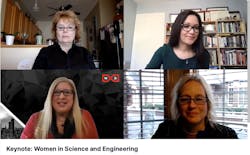A WISE Panel Reviews the Effects of the Pandemic on the Workforce
At a Glance:
- Why the recession resulting from COVID-19 is taking an economic and societal toll on women.
- A panel of women in science and engineering (WISE) discuss steps manufacturers can take to mitigate the downsides created by the pandemic.
- Convening at Design Summit 2020, the virtual roundtable asked women to draw from experience and highlight new markers for success: collaboration, diversity and inclusion.
During “normal” recessions, men face greater risk of unemployment than women. But this is not a normal recession: The economic downturn resulting from the COVID-19 pandemic is having a singular effect on women.
One reason, according to a working paper issued by the National Bureau of Economic Research, is that relatively more men work in cyclical sectors such as manufacturing and construction, while women’s employment is concentrated in health care and education. The current crisis has a big impact on service occupations with high female employment shares, such as restaurants and hospitality.
Similarly, a McKinsey study (“Women in the Workplace 2020”) that tracks the progress of women in America found that the unprecedented events brought on by the pandemic have shifted the boundaries between work and home and is disproportionately hurting women’s employment.
According to the data, the pandemic’s impact, including social distancing and lockdown measures, has penalized women more than men, and women of color in particular are more likely to be furloughed or laid off. Along with traditional barriers to advancement, the dynamics posed by the pandemic—such as working “double shifts” (a full day’s work along with caring for children) and increases in racial violence—tell the story of why more than one in four women contemplate downshifting their career or leaving the workforce completely.
There is a silver lining, argued a panel of women during the Women in Science and Engineering keynote at Design Summit 2020 (Nov. 16-19). While the crisis may upset an already lopsided distribution of labor and the division of labor in the home, the panelists contended that employers are becoming aware of their employees’ needs and increasingly opt for flexible work arrangements that benefit both genders.
The challenges are universal and the statistics bring an observable and heightened awareness to blind spots in hiring and retention practices across sectors, including the need for more flexible options and opportunities for women in manufacturing so they can achieve their potential over the long term. Regardless of the manufacturing sector, panelists said there are steps the industry can take to mitigate bias.
“Industries need to get really creative with how women can still be present in the workforce and present in life, and this situation that we’re in is actually a great opportunity to learn,” said Sherman, who currently holds more than 140 U.S. patents and is the only woman among 18 employees who have reached 100 patents.
Even with a supportive life partner, the drive to succeed and the willingness to make sacrifices, the deck has yet to be stacked to favor women. That’s especially true when it comes to compensation, noted Sherman. “I used to joke to my boss and say, ‘You’ll never get rid of me because I’m a cheap date. You’ll keep me because I work twice as hard for less than the guys do.’ It’s a sad thing that’s honestly the truth.”
Chandra Brown, CEO of MxD, a digital manufacturing institute that supports U.S. factories with digital tools, cybersecurity and workforce expertise, agreed with Sherman that compensation continues to be a sticking point, with women earning 81% of the earnings of male full-time wage and salary workers.
Still, the panelists remained optimistic about the changing landscape as more women enter manufacturing roles. At MxD, Brown works to fix the “leaky pipeline” (the idea that women—and minorities—are lost from the pipeline once they reach experienced, mid-career levels in their career) with opportunities brought about by the digital and the cyber workforce of the future.
“It is projected that 2.4 million jobs could remain unfilled due to a skilled shortage,” Brown said. “That’s a huge problem, and equals huge opportunity, particularly for the underrepresented in manufacturing, which is women and other minority and diverse populations and underserved communities. We must reach out to [manufacturers to bridge gaps] where their staff will never be filled.”
MxD is part of Manufacturing USA, a network of 14 public-private innovation centers for advanced manufacturing that forms partnerships between government, academia and industry. The organization has released “The Hiring Guide: Cybersecurity in Manufacturing,” a playbook describing 247 job roles; it sets out career pathways that will pave the way for jobs crucial to the future of cybersecurity.
More robust leadership development and workforce development programs and tools can make it easier, agreed Tomei. But when it comes to conversations about gender balance and compensation, companies struggle to engage freely in discussions about where the shifts are.
“Overall, we know that manufacturing pays more and offers more benefits than our service sector jobs, but as an industry we can’t talk out of both sides of our mouths,” Tomei said. “We cannot pursue more females in a manufacturing setting and then not offer the same pay that our male counterparts are getting…Employers can no longer ask employees about their former salaries.”
A lesson learned from working in a COVID environment, where everybody is working differently than they did nine months ago, noted Tomei, is that employers need to look at the quality of the output as opposed to how it got done. “Employees have had the flexibility to focus on the particular task at hand—in a different environment, but on their schedule—and everybody has had to adapt to that. So, I think employers are starting to embrace that.”
Click here to watch the complete keynote session on "Women in Science and Engineering."
About the Author

Rehana Begg
Editor-in-Chief, Machine Design
As Machine Design’s content lead, Rehana Begg is tasked with elevating the voice of the design and multi-disciplinary engineer in the face of digital transformation and engineering innovation. Begg has more than 24 years of editorial experience and has spent the past decade in the trenches of industrial manufacturing, focusing on new technologies, manufacturing innovation and business. Her B2B career has taken her from corporate boardrooms to plant floors and underground mining stopes, covering everything from automation & IIoT, robotics, mechanical design and additive manufacturing to plant operations, maintenance, reliability and continuous improvement. Begg holds an MBA, a Master of Journalism degree, and a BA (Hons.) in Political Science. She is committed to lifelong learning and feeds her passion for innovation in publishing, transparent science and clear communication by attending relevant conferences and seminars/workshops.
Follow Rehana Begg via the following social media handles:
X: @rehanabegg
LinkedIn: @rehanabegg and @MachineDesign



